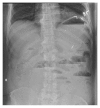Reversible Inferolateral ST-Segment Elevation Associated with Small Bowel Obstruction
- PMID: 28465689
- PMCID: PMC5390630
- DOI: 10.1155/2017/5982910
Reversible Inferolateral ST-Segment Elevation Associated with Small Bowel Obstruction
Abstract
ST-segment elevation is an important and alarming electrocardiographic sign that necessitates immediate attention but does not always indicate that the primary pathology is cardiac in origin. It needs to be interpreted in the clinical context as several pathological conditions involving especially gastrointestinal tract may lead to delayed diagnosis and treatment as well as complications from invasive unnecessary interventions. We present two patients, a 64-year-old male and a 71-year-old female, who were admitted to the emergency room of a community-based hospital with similar complaints of worsening epigastric abdominal pain and were diagnosed later with small bowel obstruction. Both patients reported a history of abdominal surgeries in the past. Also in both patients the ECG showed signs of ST-segment elevation in inferior and lateral leads. These ECG changes were related to the intra-abdominal pathology as no evidence of contributing coronary artery disease could be found. In addition, prompt resolution of ST-segment elevation was seen after surgical treatment. The pathophysiological etiology of electrocardiographic changes accompanying small bowel obstruction is yet to be explored.
Figures







Similar articles
-
Small Bowel Obstruction Mimicking Acute ST-Elevation Myocardial Infarction.Case Rep Surg. 2015;2015:739147. doi: 10.1155/2015/739147. Epub 2015 Mar 8. Case Rep Surg. 2015. PMID: 25838963 Free PMC article.
-
Gastric dilatation and intestinal obstruction mimicking acute coronary syndrome with dynamic electrocardiographic changes.BMC Cardiovasc Disord. 2016 Nov 29;16(1):245. doi: 10.1186/s12872-016-0423-z. BMC Cardiovasc Disord. 2016. PMID: 27899069 Free PMC article.
-
Electrocardiographic ST segment elevation: a comparison of AMI and non-AMI ECG syndromes.Am J Emerg Med. 2002 Nov;20(7):609-12. doi: 10.1053/ajem.2002.35454. Am J Emerg Med. 2002. PMID: 12442239
-
Acute total occlusion of the left main coronary artery with emphasis on electrocardiographic manifestations.Timely Top Med Cardiovasc Dis. 2007 Aug 1;11:E22. Timely Top Med Cardiovasc Dis. 2007. PMID: 18297153 Review.
-
The role of the initial 12-lead ECG in risk stratification of patients with acute coronary syndrome.Bratisl Lek Listy. 2001;102(9):406-11. Bratisl Lek Listy. 2001. PMID: 11763676 Review.
Cited by
-
No small dilemma: small bowel volvulus mimicking acute coronary syndrome.Oxf Med Case Reports. 2024 Jul 30;2024(7):omae080. doi: 10.1093/omcr/omae080. eCollection 2024 Jul. Oxf Med Case Reports. 2024. PMID: 39087087 Free PMC article.
-
ST-Segment Elevation in Conditions of Non-cardiovascular Origin Mimicking an Acute Myocardial Infarction: A Narrative Review.Cureus. 2022 Oct 30;14(10):e30868. doi: 10.7759/cureus.30868. eCollection 2022 Oct. Cureus. 2022. PMID: 36465741 Free PMC article. Review.
-
Thrombolysis of bowel obstruction? A thought-provoking presentation of a common surgical pathology.J Surg Case Rep. 2023 Mar 28;2023(3):rjad189. doi: 10.1093/jscr/rjad189. eCollection 2023 Mar. J Surg Case Rep. 2023. PMID: 36998254 Free PMC article.
-
Gastric perforation mimicking ST-segment elevation myocardial infarction.BMJ Case Rep. 2021 Mar 9;14(3):e237470. doi: 10.1136/bcr-2020-237470. BMJ Case Rep. 2021. PMID: 33687933 Free PMC article.
References
-
- Takato T., Ashida T., Sugiyama T., Yoshida Y. Marked reversible ST-T abnormalities induced by cardiac compression from a retrosternal gastric tube used to reconstruct the esophagus after tumor resection: a case of a diabetic patient and mini-review of 7 reported patients. International Heart Journal. 2006;47(3):475–482. doi: 10.1536/ihj.47.475. - DOI - PubMed
Publication types
LinkOut - more resources
Full Text Sources
Other Literature Sources
Miscellaneous

